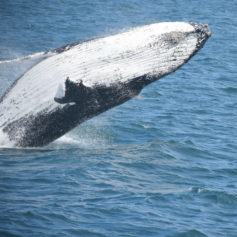Alex Jones, a CUAVA PhD student, has spent five weeks doing field work in Jervis Bay. She has been assessing the significance of this area to the east Australian humpback whale population, specifically for females with calves, during their southern migration.
Alex’s research aims to investigate the habitat usage patterns of humpback whales in the Jervis Bay area, which has significant recreational and naval activity. For five weeks over September and October, dedicated land-based theodolite surveys were conducted from the Point Perpendicular Lighthouse. These surveys recorded the movement of the whale groups bypassing and entering the Bay, their behaviour and group composition. In addition, photo-ID images were taken on-board a local whale watching vessel to determine the minimum residency time of groups in the Bay.
There was a clear trend of mother-calf groups entering the Bay in mid-October as these groups use calm and sheltered waters to rest, and for calves to feed, before making their way south to Antarctic summer feeding grounds.
This year was the first of three field seasons (2018-2020).






